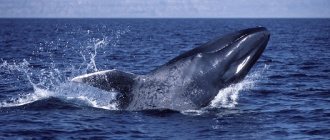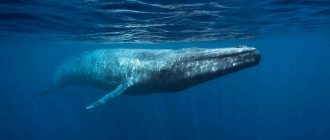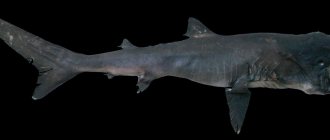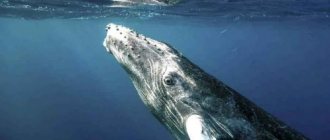17 January112696aquatic inhabitantswhaleslarge
The blue whale or blue whale is a marine animal that is a member of the cetacean order. The blue whale belongs to the baleen whales of the genus minke whales. The blue whale is the largest whale on the planet. In this article you will find a description and photo of a blue whale, you will learn a lot of new and interesting things about the life of this huge and amazing animal.
What does a blue whale look like?
The blue whale looks very huge, but it has an elongated and slender body. The large head of this whale is equipped with small eyes and a sharp muzzle with a wide lower jaw. The blue whale has a blowhole, from which it releases a vertical fountain of water up to 10 meters high when exhaling. On the head in front of the blowhole, the blue whale has a noticeable longitudinal ridge called the “breakwater”.
The blue whale has a dorsal fin that is strongly displaced back. This fin is very small and has the shape of a pointed triangle. The back edge of the whale's fin is covered with scratches, which form an individual pattern for each whale. Using such patterns, researchers can distinguish each individual. The length of this fin is only 35 cm.
The blue whale has narrow, elongated pectoral fins that reach up to 4 meters in length. The caudal fin of the blue whale reaches up to 8 meters in width, it has a thick caudal peduncle and a small notch. All these elements help the blue whale easily control its large body in the water.
The blue whale looks very unusual thanks to its longitudinal stripes. Like all minke whales, the blue whale has many longitudinal stripes on the underside of its head that continue down its throat and belly. These stripes are formed by folds of the skin and help the blue whale's throat stretch when it swallows large volumes of water and food. A blue whale usually has about 60-70 such stripes, but there can be more.
The blue whale is the largest whale of all cetaceans at present. Also, the blue whale is the largest animal on Earth. The size of the blue whale is enormous and makes a strong impression. The giants, 30 meters long and weighing more than 150 tons, are amazing. In blue whales, females are slightly larger than males.
The largest blue whale known is a female, which had a length of 33 meters, with a body weight of 190 tons. Among males, the largest blue whale weighed 180 tons, with a body length of 31 meters. Huge blue whales over 30 meters long are extremely rare today. Therefore, in our time, the length of the blue whale has decreased somewhat. At the same time, the mass of the blue whale also became slightly smaller.
The length of male blue whales varies from 23 to 25 meters. The length of the blue whale in females ranges from 24 to 27 meters. The weight of the blue whale is no less impressive than its length. The weight of a blue whale ranges from 115 to 150 tons. Individuals that live in the Northern Hemisphere are a couple of meters smaller in size than those that live in the Southern Hemisphere.
The vision and sense of smell of the great blue whale are poorly developed. But his hearing and sense of touch are well developed. The great blue whale has a huge lung capacity. The amount of blood in a large blue whale is over 8 thousand liters. The tongue of a blue whale weighs up to 4 tons. Despite such impressive numbers, the blue whale has a narrow throat, its diameter is only 10 cm. The heart of the blue whale weighs a whole ton and is the largest heart in the entire animal kingdom. However, his pulse is usually 5-10 beats per minute and rarely exceeds 20 beats.
The skin of the blue whale looks smooth and even, except for the existing stripes on the throat and belly. Blue whales are almost never overgrown with various crustaceans, which often settle on other whales in large quantities. The blue whale looks rather monotonous. He has predominantly gray skin color, with a blue tint. Sometimes the blue whale looks grayer, and sometimes its color has more blue tones. The blue whale's lower jaw and head are the darkest in color, the back is lighter, and the sides and belly are the lightest on the entire body.
There are gray spots along the body of the blue whale; they have different shapes and sizes. By these spots you can distinguish one or another whale. This coloring makes the blue whale look like it is made of marble. In the tail part the number of spots increases. The pectoral fins of the blue whale on the inside are much lighter in color than the rest of the body. However, the underside of the tail is much darker than the rest of the body. Through the water column, this whale looks absolutely blue, which is why the blue whale is called blue.
In cold waters, the color of the blue whale takes on a greenish tint, as the skin of this mammal becomes overgrown with microscopic algae, which form a film on its skin. The acquisition of this shade is characteristic of all baleen whales. When the whales return to warmer waters, this coating disappears.
Inside the mouth of this giant there are plates of whalebone, about a meter long, which consist of keratin. The longest plates of whalebone are in the back rows, and in the front part their length decreases to 50 cm. These plates reach a width of about half a meter. One baleen plate can weigh up to 90 kg. In total, the blue whale has 800 plates on its upper jaw, 400 on each side. The blue whale's baleen is a rich black color. The baleen plates have the shape of an inverted triangle, the top of which is broken into a hair-like fringe, which is quite rough and tough.
There are three subspecies of blue whale - northern, southern and dwarf, which are slightly different from each other. Sometimes another subspecies is identified - the Indian blue whale. The first two subspecies prefer cold circumpolar waters, while the rest inhabit mainly tropical seas. All subspecies have almost the same lifestyle. The lifespan of a blue whale is quite long and can be 90 years; the oldest whale was 110 years old. The average lifespan of blue whales is 40 years.
Previously, the blue whale's habitat was the entire world's oceans. At the beginning of the 20th century, the number of huge blue whales began to decline rapidly due to active fishing. The gigantic size of the animal's carcass attracted whalers. After all, you could get a lot of fat and meat from one big blue whale. So by 1960, the blue whale was almost destroyed and was on the verge of complete extinction; no more than 5 thousand individuals remained.
Now the great blue whale is still very rare - the total number of these animals is about 10 thousand individuals. The main threat to blue whales is sea pollution and disruption of their normal way of life. Also, the growth in the number of blue whales is influenced by their slow natural reproduction.
Giraffes
The giraffe is the tallest land animal in the world. He has many positive qualities in his appearance, such as a long neck, long legs and an amazing printed color. Giraffes were first found in the regions of South Africa and Somalia. The heart of this tallest animal has amazing features. Gravity is the biggest enemy of giraffes.
The heartbeat of a long-necked animal always arouses wide interest among researchers. The structure of the giraffe's heart is well organized to meet all its needs. It is large in size and weighs more than other animals. The walls of his left ventricle are 7 cm thick and beat three times per second.
The book was returned to the library 72 years later
Aquarius - listen to intuition: forecast for all signs for the spring equinox
“Don’t divide yourself into parts”: Tina Kandelaki on how to find your man
The most important feature of the giraffe's heart is that it has high blood pressure, which prevents the animal from fainting when raising its head. Blood pressure allows the arteries to supply blood to the brain. Interestingly, the principle of blood flow in the giraffe's body has served as the basis for many inventions, such as pilot suits, for example.
Where does the blue whale live?
The blue whale lives in the waters of many states and territories throughout our planet. Previously, the blue whale's habitat occupied the entire world's oceans. Now the blue whale lives in different waters, depending on the subspecies. The northern and southern subspecies of blue whales live in cold waters. The southern subspecies is mainly found in cold subantarctic waters. Dwarf whales prefer life in warmer waters.
The blue whale animal rises quite far to the north - southern blue whales have been spotted off the coast of Chile, South Africa and Namibia. In the Indian Ocean, the blue whale lives in equatorial waters all year round. They are especially often seen near Ceylon and the Maldives, as well as in the Gulf of Aden and the Seychelles. These are the best places on the planet for those who want to see whales.
In the Pacific Ocean, blue whales are found off the coast of Chile. But they are absent off the coast from Costa Rica to California. At the same time, blue whales are becoming numerous in California waters. The blue whale lives from the Oregon coast to the Kuril Islands and to the Aleutian ridge, but does not go far into the Bering Sea.
Great blue whales are no longer present in waters near Japan and Korea, but were once present. Blue whales are extremely rare in Russian waters. Small groups and single animals were seen near Cape Lopatka (the southernmost point of the Kamchatka Peninsula).
In the North Atlantic Ocean, blue whales are few in number compared to the number of individuals in the Southern Hemisphere. In the North Atlantic, the blue whale lives off the coast of Canada, in the areas between Nova Scotia and Davis Strait.
Blue whales are found off Iceland and in the Denmark Strait. Previously, the blue whale lived off the northwestern coast of the British Isles, the Faroe Islands and the coast of Norway. Occasionally, blue whales can be found off the coast of Spain and Gibraltar.
Blue whales are known to migrate. Whales spend the summer in the high latitudes of both hemispheres, but with the onset of winter, they migrate to warmer areas of lower latitudes. Winter migrations of the blue whale in the North Atlantic are poorly studied. It is still unclear why blue whales always leave Antarctica in winter and go north to warmer waters. Even though the previous location still has enough food.
This probably happens because females, when giving birth to their young, tend to move them away from cold areas. Because blue whale calves have a poorly developed fat layer and are therefore not sufficiently protected from the cold. After all, the developed fat layer helps maintain the body temperature of blue whales even in the coldest waters.
Existential threats
The International Red Book notes that there are currently no direct threats to the blue whale population. A significant threat to blue whales comes from sea pollution, including oil products. Tests conducted in the mid-1990s showed that toxic chemicals (polychlorinated biphenyls) accumulate in the blubber tissue of blue whales and enter the sea. It is especially alarming that these substances, which accumulate in the body of pregnant females, are transmitted to the cubs while still in the womb. Due to the small number of individual herds and, as a consequence, inbreeding, the accumulation of genetic defects and degeneration can play an important negative role.
Due to their gigantic size, blue whales have almost no natural enemies. However, young and sometimes adult individuals can become victims of attacks by killer whales, which, acting together, can tear them apart and eat them.
There are cases of whales dying under ice - in the Northern Hemisphere, apparently in late winter and early spring.
How does a blue whale live?
Blue whales live alone, sometimes in small groups. But even in groups they swim separately. The blue whale is a diurnal mammal. The blue whale lives using vocal signals to communicate with its relatives. The sounds that the blue whale makes are infrasounds. They are very intense. Blue whales use infrasound signals to communicate over long distances during migrations.
Blue whales are able to communicate using signals over distances of up to 33 km. The blue whale's voice is extremely loud. There are known cases of recording the very intense voice of a blue whale at a distance of 200, 400 and even 1600 km. The blue whale also uses its signals to find a partner to start a family.
In general, the blue whale lives with a greater tendency to be alone than all other cetaceans. But sometimes blue whales live in small groups. In places where there is an abundance of food, they can create noticeable aggregations, which are divided into small groups. In these groups, blue whales keep to themselves. But the total number of such aggregations of blue whales can reach 50-60 individuals.
The blue whale can dive quite deep. The blue whale is capable of diving to depths of up to 500 meters for up to 50 minutes. Typical dives for a feeding blue whale are between 100 and 200 meters deep. Such dives last from 5 to 20 minutes.
A feeding whale dives rather leisurely. After surfacing, the whale's breathing accelerates, and it emits a fountain. When breathing is restored, the whale dives again. A blue whale at rest breathes up to 4 times per minute. Young whales breathe more frequently than adults. After a long dive to depth, the blue whale makes a series of short surfaces and shallow dives. During this time, the whale swims 40-50 meters.
The blue whale looks quite imposing and impressive when it jumps out of the water. The most spectacular surfaces are the first one after rising from the depths and the last one before diving. The whale surfaces, showing the very top of its head, then its back, dorsal fin and caudal peduncle.
When a blue whale dives into the depths, it tilts its head downwards. When the head is already deep under water, a part of its back with a fin is shown on the surface, which is always the last to go under water. The whale sinks lower and lower until it disappears under the water, never showing its tail. The blue whale lives by spending 94% of its time underwater.
Over short distances, the blue whale can reach speeds of up to 37 km/h, and in some cases up to 48 km/h. But the whale cannot maintain this speed for a long time, since it is too much stress on the body. The whale produces up to 500 horsepower at this speed. A feeding blue whale moves slowly, within 2-6 km/h. But during migrations its speed increases to 33 km/h.
Because the whale is so large, adult blue whales have no natural predators. But young blue whales can become victims of attacks by a pod of killer whales. These predators drive the whale into the depths in a flock, where it weakens from lack of oxygen. The weakened animal will be able to be torn apart and eaten by killer whales.
There are currently no direct threats to the blue whale population. But there is a danger that long networks of 5 km pose for them. A huge number of marine life die in such nets, although only one case of blue whales dying in them is known. In other cases, according to fishermen, large blue whales easily overcame such nets. Off the coast of Western Canada, blue whales have many markings on their skin from various fishing gear.
Blue whales also die in the Pacific Ocean from collisions with ships, the average is 1-2 cases per year. Some animals in the Gulf of St. Lawrence area have scars from collisions with ships. This is caused by the high concentration of blue whales combined with heavy shipping traffic in the area of these waters. Today, despite the protection of blue whales, even in places where they are most numerous, there are still no restrictions on shipping. There are only recommendations to slow down in these waters, which are not followed by captains.
Nowadays, the greatest threat to blue whales comes from sea pollution, including oil products. Toxic chemicals that enter the sea accumulate in the fatty tissue of blue whales. It is especially dangerous when these substances accumulate in the body of females who are expecting the birth of cubs.
Human impact also affects the number of blue whales by disrupting their communications. The background noise of the sea has recently increased too much and the vocal signals of large baleen whales are often drowned out. After all, the noises that ships make have the same frequency as the voices of whales.
In connection with this, it becomes more difficult for whales to navigate and look for relatives, which also makes it difficult to find a partner during the mating season. The greatest damage in this case is caused by the hydroacoustic systems of warships, which operate in active mode.
Features of communication
Blue whales travel alone for most of their lives, sometimes in groups of 2-3 individuals. Large flocks, which may include 60 animals, have been recorded in places where food accumulates.
But there is one “but” here. The blue whale has the strongest voice of all animals, the low frequencies of which can spread in the deep-sea environment for many hundreds and even thousands of kilometers. Therefore, what may seem to people like “solo” sailing, in reality, is not so. Thanks to the ability for such negotiations, a solitary whale is often in close contact and communication with its relatives.
What does the blue whale eat?
The blue whale feeds on plankton, which is typical for baleen whales. The mammal blue whale has an excellent filtering apparatus, which is formed by the plates of the whalebone.
The blue whale feeds on krill, which is the main food in its diet. Sometimes the blue whale feeds on larger crustaceans and small fish. But still, small crustaceans predominate in the blue whale’s food composition. Massive aggregations of such crustaceans are called krill. In the photo below you can see a cluster of krill in the ocean.
Fish plays a minor role in the blue whale's diet. When ingesting masses of krill, the huge blue whale may accidentally ingest small fish, small squid and other marine animals. Sometimes the blue whale feeds on small crustaceans that are not krill.
The blue whale eats the same way as other minke whales. The whale swims slowly with its mouth open and takes in water with a mass of small crustaceans. The whale's mouth is very stretchable thanks to the stripes on the throat and the movable bones of the lower jaw. Having scooped up water with crustaceans, the whale closes its mouth. At the same time, the blue whale's tongue pushes water back through the whalebone. And the plankton that settles on the fringe of the mustache is swallowed.
The huge lower jaw, which is filled with water and food, becomes very heavy. Sometimes the weight is so heavy that it is difficult for the blue whale to move its jaw to close its mouth.
Therefore, the blue whale, taking food into its mouth, turns over on its side or back to make it easier to close. In this position, the mouth closes itself under the influence of gravity.
Due to its size, the blue whale is forced to consume a lot of food - a blue whale can eat from 3 to 8 tons of krill per day. A blue whale needs approximately 1.5 tons of food per day.
Subspecies
The question of the subspecies of the blue whale has not been completely resolved, but most sources indicate that there are three subspecies:
- Northern (Balaenoptera musculus musculus) ; type subspecies
- Southern (Balaenoptera musculus intermedia) . This is the most numerous subspecies and has always constituted the bulk of the world's vomiting herd. The main difference from the type subspecies is its larger size, but in general there are few external signs by which the southern blue whale can be reliably distinguished from the northern one when observed at sea.
- Dwarf (Balaenoptera musculus brevicauda) , sometimes called the pygmy blue whale. This subspecies is conventionally called dwarf - the average length of dwarf blue whales is only 3 meters less than that of other subspecies. The coloring of these whales is lighter, they also differ in body type, the length of their caudal peduncle is shorter, which, according to observers, immediately catches the eye when a whale dives. The body of the pygmy blue whale is somewhat thicker and teardrop-shaped than that of the type subspecies, and the baleen plates are shorter.
Baby blue whale
The natural growth of the blue whale occurs very slowly. The blue whale is the animal in which this process is the slowest among all baleen whales. Female blue whales give birth once every two years. This period can increase or decrease, it depends on the density of the blue whale population. In recent decades, it has unfortunately declined. The blue whale is a monogamous animal. Blue whales form long-lasting pairs. The male always stays close to the female, both during pregnancy and after the birth of the baby.
The duration of pregnancy for a female blue whale lasts about 11 months. Most often, one blue whale calf is born. The little giant is born 6-8 meters long and weighing 2-3 tons. Immediately after birth, a blue whale calf can move independently. The baby is born tail first. Females have a very developed maternal instinct, they are deeply attached to their cubs.
Blue whale calves, accompanied by females, begin to be seen from December to March. Breastfeeding for blue whale calves lasts about 7 months. During this time, the blue whale calf reaches up to 16 meters in length and weighs 23 tons.
A blue whale calf consumes up to 90 liters of milk per day. Reaching the age of 1.5 years, a blue whale calf grows to 20 meters in length and 45-50 tons of weight. The milk of a female blue whale is very fatty and rich in protein. Its fat content ranges from 37 to 50%.
Blue whales become capable of breeding offspring at the age of 8-10 years. By this age, females reach 23 meters and weigh about 90 tons. The blue whale reaches its full length and bodily maturity by 15 years of age.
Don’t forget to subscribe to updates on our website and join us on social networks (Vkontakte, Odnoklassniki, Instagram) so you don’t miss anything and always stay up to date with all the news!
Don't forget to share with your friends!
Appearance and structure
The physique is proportional, the body is well streamlined. The head is convex from the sides, but blunt in front. The respiratory opening (blowhole) is surrounded in front and on the sides by a ridge that turns into a ridge, which, gradually lowering, ends at the end of the snout. The eyes are small, located slightly behind and above the corner of the mouth. The length of the eye slit is 9-10 cm. The lower jaw is strongly curved to the sides; when the mouth is closed, it protrudes in front of the snout by 15-30 cm. On the front of the head and lower jaw there are several dozen short (15 mm) hairs, the number of which varies.
The miniature dorsal fin is set far back, its height is only about 30 cm and can have a variety of shapes (with a rounded end, triangular, etc.). The pectoral fins are narrow, pointed and somewhat shortened (1/7 – 1/8 of the body length). The width of the caudal fin with a small notch in the middle is equal to 1/4 of the body length. The head is wide on top, U-shaped, with convex edges to the side. There are 70-114 longitudinal skin “stripes” on the belly, with an average of 80. The depth of the thoraco-abdominal stripes is up to 2 cm, the width is about 5-6 cm. The longest ones reach almost to the navel.
The body of the blue whale is dark gray, with a bluish tint, mottled with light gray spots and a marbled pattern. The head, lower jaw and chin are the same color. There are more spots in the back half of the body and on the belly than in the front and on the back. The belly may be yellow or mustard in color. The heart weighs more than half a ton. The diameter of the aorta reaches the diameter of a small bucket, and the lungs can hold up to 14 m3 of air.
The thickness of the fat layer is from 7-8 cm to 15 cm, sometimes up to 20 cm. Parasites from the class of crustaceans sometimes live on the skin of the blue whale - whale lice (penella) and barnacles (coronula and xenobalanus), the shells of which are immersed at the base of the skin. Copepods (Balenophius) and the round worm Odontobius were found in the oral cavity on whalebone. In feeding areas, its skin, like that of all minke whales, is overgrown with a green film of diatoms, which disappears in temperate and warm waters.
Reproduction
The peak of mating for blue whales occurs in winter: in January in the northern hemisphere and in July in the southern hemisphere. The body length of newborns is from 6 to 8.8 m, more often 7-8 m, with a weight of 2-3 tons. A strong variation in the size of embryos obtained at the same time indicates that mating periods are extended over almost the entire year. An analysis of the size of embryos in Antarctic catches showed an average increase in their body in November by 35 cm, in December by 56, in January by 72, in February by 92 and in March by 79 cm (Tomilin, 1957). Apparently, the growth rate of the embryos gradually increases, but towards the end of uterine life it slows down somewhat.
Pregnancy lasts a little less than a year (about 11 months). Usually one cub is born; cases of multiple births are rare. According to the International Whaling Statistics (ISS), among 12,106 Antarctic embryos, there were 77 cases of twins, five cases of triplets, one find with five and one with seven embryos. Of the twin embryos, as a rule, only one develops to the end, the rest die and are resorbed. During the 7-month lactation period, the cub, feeding on very fatty milk (34-50% fat), grows up to 16 m and weighs 23 tons, and at the age of 19 months it reaches 20 m and weighs 45-50 tons; medium individuals (23.7-24 m) weigh 80-85 tons, and large ones (30 m) - 150-160 tons (Wheeler and Mackintosh, 1929; Krogh, 1934; Ruud, 1956). Puberty occurs at 4-5 years, as evidenced by 8-10 layers in the ear plugs, which are used to determine age. Females at this time reach a length of 23 m. They reach full growth and physical maturity at a body length of 26-27 m, which probably happens at 14-15 years.
The average daily weight gain of sucklings, according to zootechnical calculations (Tomilin, 1946), reaches 81.3 kg with a daily consumption of 90 kg of milk. Puberty occurs at 4-5 years, when 8-10 layers appear in the ear plugs, which are used to determine age (Nishiwaki, 1957); at this time, the length of southern females reaches an average of 2-3.78 m, northern ones - 23 m, and the average weight of the testes of males is 10 kg (Ruud, 1950, 1957). Females usually breed every two years. The strong variation in the percentage of pregnant females among sexually mature ones (from 20 to 61%: Laurie, 1937; Ottestad a. Ruud, 1936) depends on the accuracy of registration of embryos at whaling bases and on the number of individuals studied (with less material, larger deviations are possible).
Females reach physical maturity when 11-12 scars of the corpus luteum accumulate in the ovaries; this occurs at 14-15 years of age, and possibly at an even older age, with an average body length of 26.2 m (Laurie, 1937), 26.5 m (Brinkmann, 1948) and 26.67 m (Peters, 1939 ). The minimum size of physically mature Antarctic females is set at 24.7 m, and for males - 22.3 m. A female with 41 scars of the corpus luteum (18 in one ovary and 23 in the other) already had signs of menopause, and with 35 scars was without such signs . The oldest female in the North Pacific has only 25 scars (Omura, 1955).











